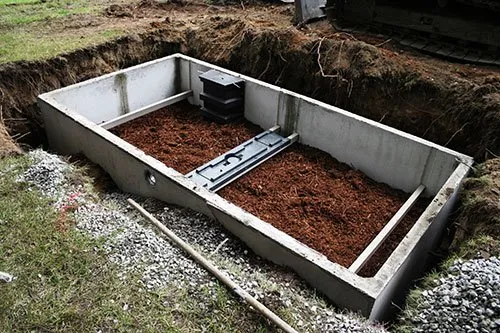Easy Guide: How to Clean Septic Tank Filter in 5 Simple Steps
Learn how to clean septic tank filters in 5 easy steps. Save money and prevent costly backups with our simple maintenance guide. Cleaning your septic tank filter is simple: remove it, spray it with a garden hose, and put it back in place. The whole process takes about 30-45 minutes and helps prevent costly backups in your home.
Here’s the deal: a clean filter keeps your septic system running smoothly and stops nasty odors from creeping into your house.
I know cleaning a septic filter sounds gross (and it kind of is). But with the right safety gear and my step-by-step guide, you’ll be done before your morning coffee gets cold.
In this guide, you’ll learn:
- The exact safety gear you need
- Where to find your filter (even if you’ve never seen it)
- My 5-step cleaning method that makes the job quick and easy
- How to tell if your filter is working right
But first, grab some rubber gloves and a face mask safety always comes when dealing with septic systems.
How to Clean Septic Tank Filter?
Safety First: Essential Preparation Steps

Want to clean your septic tank filter but worried about doing it safely? Let me show you exactly what you need:
Here’s what you’ll need to grab first:
- Protective gear: rubber gloves, safety goggles, and a face mask
- Basic tools: garden hose, bucket, and scrub brush
- Optional: pressure washer for tough buildup
Best Time for Cleaning
The perfect time to clean your septic filter is early morning or late afternoon. Why? The tank produces less waste during these hours, making your job easier and safer.
But before you start: * Check the weather forecast – avoid rainy days * Make sure it hasn’t rained heavily in the past 24 hours * Pick a time when family water usage is low
Safety Planning Tips
Keep your family in the loop with these simple steps: * Tell everyone to avoid using water while you’re cleaning * Keep kids and pets away from the work area * Have someone nearby (but at a safe distance) in case you need help * Place safety cones or markers around the work area
Remember: proper ventilation is super important. Never lean directly over the tank opening, and always work in a well-ventilated area.
Pro tip: If you smell something funky or feel dizzy, stop what you’re doing and step away. Safety always comes first when dealing with septic systems!
Finding and cleaning your septic tank filter doesn’t have to be a headache. I’ve helped hundreds of homeowners master this simple task, and today I’m going to show you exactly how to do it.
Here’s the deal: A clean septic filter is like a bouncer at a club – it keeps the bad stuff from getting into places it shouldn’t.
Locating Your Filter Like a Pro
Let’s be real – you can’t clean what you can’t find. Most septic tanks have their filters in one of three spots: the outlet baffle, the second compartment, or a separate housing unit.
Finding Common Access Points
Look for these telltale signs of your filter location:
- Round plastic lids on your lawn (usually black or green)
- Small raised pipes sticking out of the ground
- Concrete covers near your tank
- System diagrams from your last inspection
Tips for Tricky Filters
Can’t spot your filter? Try these tricks:
- Check your maintenance records for location notes
- Look for arrows on the tank lid pointing to the outlet
- Follow the pipe leading to your drain field
- Take a photo of the location once you find it (trust me, you’ll thank me later)
The 5-Step Cleaning Method That Saves Time
- Put on rubber gloves and eye protection
- Remove the filter slowly (point it downward to avoid debris spillback)
- Spray with your garden hose from top to bottom
- Look for clean water running through the holes
- Slide it back in, making sure it clicks into place
Pro tip: Clean your filter on a sunny day when the ground is dry. The last thing you want is to slip while holding a dirty septic filter!
Remember: A clean filter should let water flow freely through its holes. If you see brown water dripping after cleaning, give it another spray.
Want to save even more time? Keep a dedicated cleaning bucket and hose near your tank. The easier you make it, the more likely you’ll stick to your maintenance schedule.
Understanding Filter Performance
Your septic tank filter is like a bouncer at a club – it stops the bad stuff from getting into places it shouldn’t. But how do you know if it’s doing its job right?
Here’s the deal: A properly working filter is crucial for your entire septic system’s health.
A filter that’s working well shows these clear signs:
- Clear
- clog-free drainage
- No backup in your home’s plumbing
- No weird smells around your yard
- Normal water flow through your system
Performance Metrics to Watch
The true test of your filter’s performance comes down to simple checks:
- Water quality flowing out should be clear, not murky
- No solid debris making it past the filter
- Even, steady flow through your drain field
- No system overload warnings or alarms
Monitoring Your Filter’s Health
Keeping tabs on your filter isn’t rocket science:
- Check the filter every 3-4 months
- Look for signs of blockage or buildup
- Monitor your home’s water usage patterns
- Watch for slow-draining fixtures
Getting these checks right means fewer emergency cleanings and a longer life for your whole septic system. Plus, you’ll save big bucks on repairs – who doesn’t love that?
Remember: A happy filter means a happy septic system. And a happy septic system means no nasty surprises when you least expect them!
Preventive Measures That Work
Let’s be real: cleaning your septic tank filter isn’t fun, but it’s way better than dealing with a messy backup.
Here’s the thing: your septic tank filter is like a bouncer at a club. It stops all the nasty stuff from getting into your drain field while letting the clean water through. And just like anything that catches gunk, it needs regular cleaning.
Want to know the easiest way to clean your filter? Here’s what you’ll need:
Old clothes you don’t mind getting dirty
Practical Steps for Filter Cleaning
- Find your tank access (it’s usually that round concrete lid in your yard)
- Pop open the lid (careful – it’s heavy!)
- Pull out the filter (it looks like a long tube with holes)
- Spray it down with your hose over the tank opening
- Keep spraying until the water runs clear
- Put it back exactly how you found it
That’s all there is to it! Do this every 3-6 months and you’ll dodge most septic system problems.
Smart Maintenance Tips
Keep your filter happy by following these simple rules:
- Only flush toilet paper (no wipes, even if they say “flushable”)
- Skip the harsh chemical cleaners
- Watch out for coffee grounds and food scraps
- Use water wisely (no marathon showers!)
Remember: a clean filter means no backups, no weird smells, and no expensive repairs. Pretty sweet deal, right?
Pro tip: Mark your calendar for cleaning days. Trust me, your future self will thank you!
When to Call the Professionals
Let’s face it: septic tank maintenance can be a tricky business. While cleaning your filter yourself is often doable, some situations call for expert help.
Here’s the deal: knowing when to DIY and when to call the pros can save you thousands in repairs.
Clear Warning Signs That Need Pro Help
Your septic system is crying for professional help if:
- You notice foul odors around your yard
- There’s sewage backup in your home
- The grass over your drain field is unusually green
- Your septic tank alarms are going off
- Multiple plumbing fixtures are draining slowly
- You haven’t had a professional inspection in over 3 years
Cost vs. Risk Assessment
Trying to save money can backfire big time. Consider this:
- A professional cleaning costs $200-400
- DIY gone wrong? Septic repairs can hit $5,000+
- Complete system failure? That’s $20,000+ for replacement
The pros bring: Safety equipment to handle harmful gases
- Special tools for tough clogs
- Knowledge of local health standards
- Proper waste disposal methods
- System inspection expertise
If you spot these issues or feel unsure, don’t risk it. Call a certified septic professional. They’ll check your entire system, not just the filter, giving you peace of mind and protecting your investment.
Remember: when it comes to septic maintenance, sometimes spending a little now saves a lot later.
Maximizing Your Filter’s Lifespan
Want to know the secret to keeping your septic tank filter working like new? Here’s the deal:
Taking care of your filter isn’t just about cleaning – it’s about smart maintenance that saves you money and headaches down the road.
Smart Maintenance Tips That Work
Start by checking your filter every 3-4 months. Think of it like changing your car’s oil – regular checks stop big problems before they start.
Clean your filter when it’s covered in debris or you notice slow drains. Just remove it carefully, spray it with your garden hose, and let the gunk wash away into your septic tank.
Never use harsh chemical cleaners they’re like feeding poison to your system. Stick to water and a gentle brush.
Making Smart Choices for Better Performance
Match your cleaning schedule to your family size. A house with 4 people needs more frequent cleaning than a couple living alone.
Keep an eye on what goes down your drains. Fats, coffee grounds, and “flushable” wipes are your filter’s worst enemies.
Watch your water use. Running too many water-heavy appliances at once can overwhelm your system and clog your filter faster.
Replace your filter when you notice:
- Cracks or holes
- Warping
- Brittleness
- It’s over 5 years old
Think of your septic system like a pet give it regular attention and care, and it’ll be your friend for years to come.
Smart Maintenance Tips: Your Next Steps
Here’s the deal:
You’ve now got all the tools you need to keep your septic tank filter in top shape. And I bet you’re feeling more confident about tackling this task on your own.
Think about it: A clean filter means a happy home and zero surprise backups – that’s worth every minute you spend on maintenance.
Ready to take control of your septic system? At United Sewer & Septic, we help homeowners in Orange County, Rockland County, and Sullivan County keep their systems running smoothly. Whether you want to DIY or need a pro to handle it, we’ve got your back.
Want a free estimate for your septic needs? Just fill out our quick form on the homepage, or give us a call. We’ll help you create a maintenance plan that fits your schedule and budget.
Remember: A little care today saves big headaches tomorrow. Let’s keep your septic system running like clockwork.





